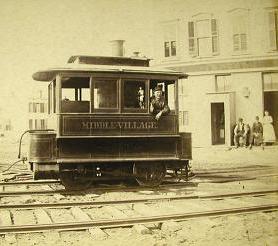Dummies were trolley-like cars pulled by steam locomotives, which used coal for fuel. It was from the small engine-car however, that name “dummy” derived. These steam engines were short and miniature, rolling along on four wheels. The inevitable smokestack jutted up through the roof. They were slow, chugging along at 10 miles per hour. Their black smoke would billow into the air, making them one of the first polluters of the air.
In 1878 the Bushwick R. R. ran to Stroebel's Hotel on Myrtle and Cypress Ave. They wanted to continue the railroad along Cypress Avenue to the gates of Cypress Hills Cemetery. On April 4, 1878 ground was broken and in one week the rails were laid along the whole road. It was at this point that the Bushwick Rail Road surprised everyone by announcing that the new Cypress Hills branch would be operated by steam dummies. If the line had opened a few years earlier, horse cars would have been used, but in 1877 and 1878, the reputation of the steam dummy was at its height, and the adoption of this mode of propulsion was considered the latest and most progressive move possible.
The use of horses for drawing street cars was admittedly unsatisfactory, and most railway executives were on the alert for a cheap, efficient substitute, The dummy needed only one operator, was immune to diseases and heat, and best of all, could draw several cars at once during periods of peak load on Sundays and Holidays.
On Sunday, May 26, 1878 the new Cypress Hills line was opened. The dummy took 12 minutes to make the two miles to the cemetery gate and an extra 3 cents was charged. The great success of the Cypress Hills branch convinced the Company that a second branch to the Lutheran Cemetery would be equally profitable. Between the City line and the Lutheran Cemetery stretched an unbroken succession of farmlands. No villages intervened and no streets interrupted the open countryside. Before 1881 there was no direct transportation between Middle Village and Myrtle Avenue.
By December, 1880, land had been secured for a terminal on Metropolitan Avenue, between Wendel's Hotel and John Sutter's Marble Yard. A month later the railroad purchased the site for a new depot at Myrtle Avenue and Palmetto Street. By February 1881 the railroad had a right of way from Ridgewood to the cemetery. The largest problem was a swamp between the Long Island Railroad and Metropolitan Avenue. The tracks sand a number of times but it was finally solved by driving piles on each side of the roadbed.
The Lutheran Dummy Line was well constructed. It was double tracked. The dark red coaches were all new, from Pratt and Company of Philadelphia and Stephenson in New York. The eight dummies were built by the Baldwin Locomotive Works. The ride, a length of 1.5 miles, took 8 minutes and cost 5 cents for adults and 3 cents for children. Turntables were built into the street at each end of the line to turn the dummies.
On Saturday, September 3, 1881 the Lutheran Line opened. About 100 people assembled at the Ridgewood depot to be present at the formal ceremonies opening the new line. Afterward they all packed into two trains that were decorated with flags and bunting and headed for Metropolitan Avenue. They were given a tour of the new depot, then they returned to the Ridgewood depot where all were invited to a banquet served by caterers.
Though the Lutheran Line opened rather late in the season, it was a big success. The new equipment, the speed of service and the novelty of the dummy attracted many patrons. Many cemetery visitors, disgusted with the undependable service on the Metropolitan Avenue horse car, and the old, dirty cars flocked to the dummy as a faster and more comfortable mode of travel. There was only one complaint. Passengers had to pay 5 cents while the Cypress Hills passengers only paid 3 cents. Nevertheless, accommodate the traffic.
On February 4, 1882 a heavy snow storm hit Long Island which the winds piled up into drifts. The Lutheran dummy was shut down for 4 days. When the snows got too deep, passengers were carried in the dummy itself. Such service was appreciated and received editorial praise: “The dummy line between Ridgewood and Middle Village is accommodating to a degree that excites admiration….The steam cars have made occasional delays but the time made has been more regular than might have been expected…had it not been for the dummy line, Middle Village would have been cut off from the outside world.”
On August 1,1888 the Brooklyn City Railroad took over the Bushwick Railroad Company and on August 3, 1895 they converted the Lutheran Line to electric trolley cars which were less expensive to operate.
In 1979 the old station was torn down and modernized. The Middle Village El Station has been in service for 118 years.
It was remarkable how these pygmies raced along, rivaling the giant locomotives in speed. It was reported that the Lilliputian engines were finally sold to South American countries where, even today, some are said to be still in service.



